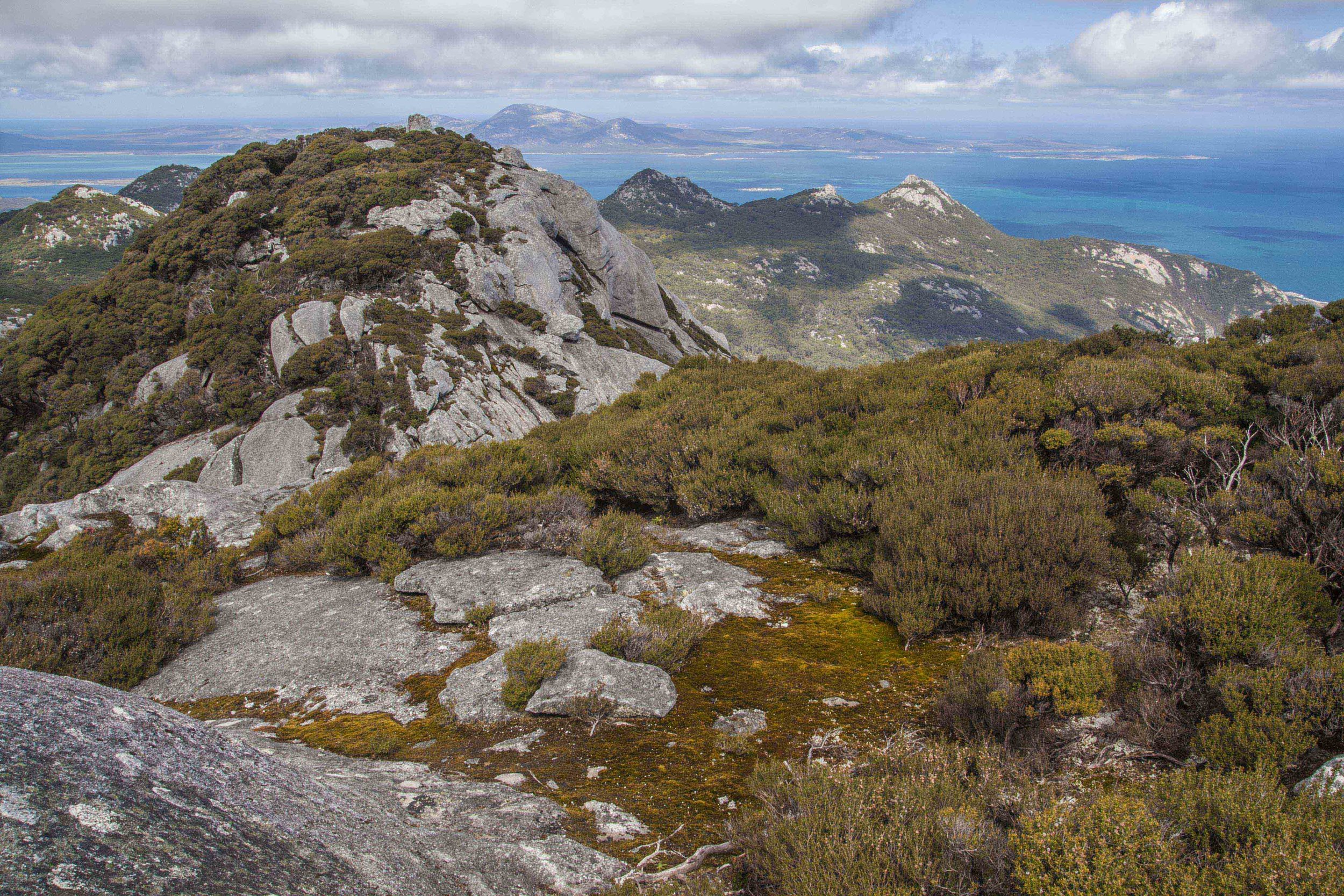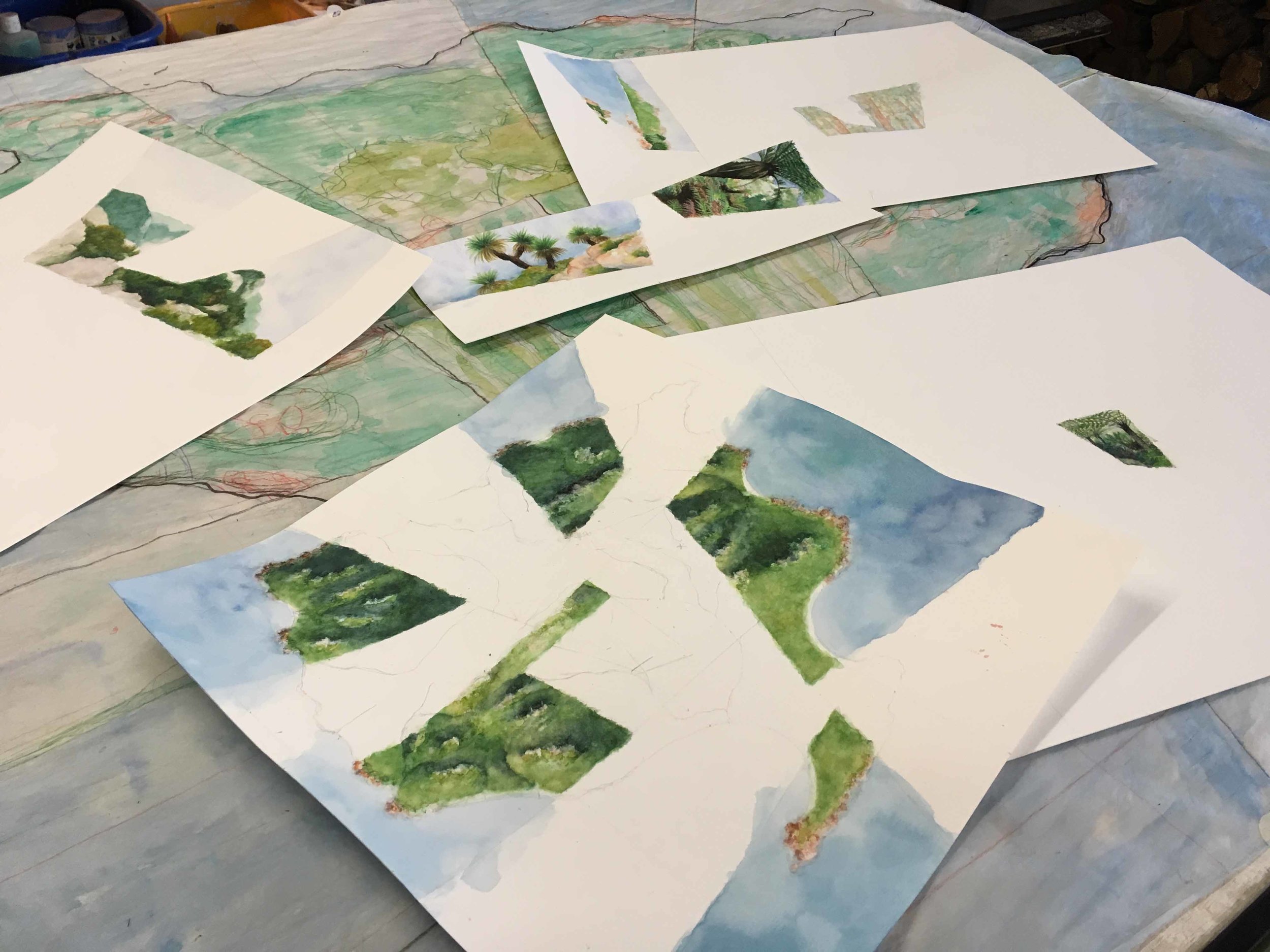Great Walk, watercolor on paper, 25”x50” (now with a proud new owner, my friend Richard Ervais!).
In fall 2017 I spent about three weeks traveling around the North and South Islands of New Zealand. Four worldviews have come out of that experience—there will be more!—including the recently completed Great Walk, inspired by the Heaphy Track in the northwest corner of the South Island.
The Heaphy Track is one of seven “Great Walks” throughout the country—multi-day treks of exceptional environmental interest maintained to a certain standard including electrified huts. The most famous of these is the Milford Track, which I did also, and you’ll definitely hear about that one too later on. But while the scenery was less dramatic, the Heaphy Track made a greater impression on me in terms of its diversity of species and ecosystems.
New Zealand with the Heaphy Track location in red.
The Heaphy Track (from the New Zealand Department of Conservation).
The 4-day “walk” (I love how the Kiwis call them “walks,” as if they’re everyday activities, and in fact they’re much more ingrained in the culture than something comparable in the USA) runs about 50 miles through Kahurangi National Park, taking in subtropical coastline, varied forest types, and high-altitude grasslands. It can be done in either direction; most walk east-west, beginning at the foot of the mountains and ending at the coast, though for logistical reasons I did it in reverse. As I’ll talk more about below, I was reminded that if such environmental journeys are experienced as narratives (which for me they always are), directionality matters as much as it would for a novel or symphony with its structure read or heard backwards.
Nikau palms along the coast, a few hours into the trek.
Rainforest with nikau palms behind the beach.
Day 1 began in the early afternoon in a light rain (actually much better weather than predicted), on a trail hugging the coastline just a few meters back from a string of beaches. Occasionally the sand is interrupted by rocky outcroppings lifting the trail upward for dramatic views along the coast, or by streams crossed by narrow suspension bridges. (Until a few years ago these stream crossings were done on foot, requiring close attention to weather and tides and resulting in more than a few tragedies.)
The most striking thing about this part of the South Island coast should be obvious from the photographs. Though at a latitude roughly equivalent to that of New York, thanks to a warm ocean current this coastline is home to the world’s southernmost naturally-occuring palm, the nikau (Rhopalostylis sapida), which is the dominant canopy species in the rainforest fringing these beaches. The nikau is noteworthy not just because palms in general are unexpected this far south, but because such a tropical-looking palm is even more surprising. Most of the world’s other hardiest palms—the Mediterranean fan palm, the needle palm, the dwarf palmetto—look decidedly non-tropical, with their shrubby forms and fan-shaped leaves. This is considered subtropical rainforest (or even temperate by some measures), but aside from the pleasant temperatures it feels as tropical as any in the quintessential “South Pacific.”
At the start of Day 2, the trail turned inland and began to climb. The palms became sparser and eventually disappeared, the exotic look of the rainforest sustained by tree ferns and giant heaths (genus Dracophyllum—in the same family as azaleas but looking deceptively like tropical houseplants). It was at this point that I started wishing I had done the walk in the more popular direction. Most people choose to end at the coast, because of the dramatic ocean views that open up on the last day plus the fact that the beach always feels like an appropriate place to end a long hike. For me though, given my obsession with palms, the reason had more to do with wishing I could have experienced the transition from temperate to tropical-like, seeing the palms slowly appear and then overwhelm. It seemed like a more natural progression, maybe because traveling from the more-familiar to the less-familiar is a storyline that tends to leave us with the strongest impressions. Briefly I decided that one day I would come back and do the walk again “properly”—though that conviction faded as I gradually realized the current progression was in fact creating its own unique narrative. More on that later.
Rainforest at a slightly higher elevation as the trail turns inland.
A gigantic southern rata, Metrosideros umbellata, with my hiking poles (bottom center with white handles) for scale.
Looking up toward the canopy of the tree in the previous image.
Giant heath (Dracophyllum sp.).
As the trail climbed higher and slowly began to level out, the character of forest became coarser, shorter, and “drier” (probably because of a change in soil type rather than precipitation), with decreasing species diversity. The tree ferns disappeared, though the occasional tropical-looking heath still stood out sharply against the tiny leaves of the surrounding foliage.
This and previous 3 images—the changing look of the forest as the trail climbs.
A boggy area of the Gouland Downs (the white on the trees in the background is a trick of the morning light, not snow).
Early on Day 3, the scrub gave way to a boggy, moody tussock grassland (the sky was mostly overcast with off-and-on rain) known as the Gouland Downs. While the landscape does look alpine in some ways, the absence of trees is due to the poor, wet soil rather than low temperatures—the elevation is only around 800m/2,600’—and in fact the grasslands are surrounded and broken up by forested hills, mountains, and rocky karst zones. Given the overall temperate look of the vegetation, I actually found the place vaguely reminiscent of a field-and-forest matrix in Europe or the Eastern USA, as English settlers apparently did too when they tried and failed to graze sheep there in the 1800’s. In any case the tropical-looking nikau forest felt a whole lot farther away than a day’s walk, a sense of separation amplified by the self-contained feel of the Downs—a special world unto itself. The forested mountains blocked any views or reminders of the more luxuriant environments below.
Looking across the Gouland Downs.
Toward the end of the day, the trail left the Downs and passed into the forest again—one very different from any of the previous types. Those were either scrubby or rainforest-y depending on the substrate; the higher-elevation ones certainly felt temperate, but still like Southern Hemisphere forests because of the unfamiliar species. This one felt like a typical forest in the northeastern USA—I think it was some combination of the spindly trees and light, ash-like foliage. It certainly seemed like I had temporarily left New Zealand.
The Enchanted Forest—mossy, gnarled beech forest in a karst (limestone) area within the Downs.
“Non New Zealand-like” forest on the other side of the Downs.
Day 4 began just before sunrise in a driving wet snowstorm. Reaching the highest point of the trip, first light revealed tropical-looking heaths with a light covering of ice, framing a view of snowy mountains across the valley that I would be following for the remainder of the walk. The weather improved, soon becoming sunny, as I descended again into ferny temperate rainforest. About 4 hours later I began to catch glimpses of an agricultural valley through the trees, the topography leveled out, and the trail exited the forest.
Sunrise vista from the highest point of the walk, with giant heaths in the foreground.
Heading downhill and back into the rainforest on the last segment of the hike.
The end of the trail, looking back toward the mountains.
In the next post I’ll describe how I distilled my experience of the Heaphy Track into Great Walk—stay tuned!
Darren



















































































